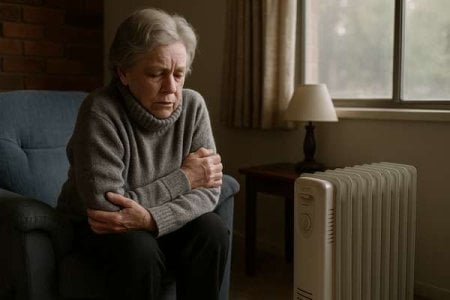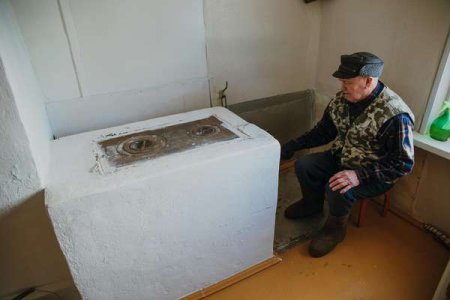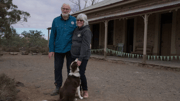Shivering Reality: Is the rising cost of this essential leaving Aussie seniors in the cold?
By
Danielle G.
- Replies 0
Millions of Australians have been shivering through this winter with the heaters switched off, and the situation is especially dire for seniors on fixed incomes. Nearly half of all households are avoiding using their heaters regularly due to fears of sky-high power bills. It’s a chilling reality when staying warm becomes a luxury, and many older Aussies find themselves bundled in blankets, hesitating to touch that thermostat.
Ask any senior about their winter routine and you’ll hear familiar stories: wearing extra jumpers indoors, warming up with cups of tea, and going to bed early just to stay under the covers. The reason? Power bills have soared after years of steep increases, forcing hard choices between heating or eating. As Finder’s energy expert Mariam Gabaji puts it, “Years of steep electricity bill increases have left Aussies paying significantly higher costs”, with some facing “the impossible decision between buying food or heating their homes”. For retirees relying on the age pension or limited superannuation, every dollar counts, and winter can mean sacrificing comfort to afford groceries and medications.
A new survey by Finder (reported by 9News) found 1 in 8 Australians go without heating “all the time”, and another 36% “avoid using the heater as often as they can”. That adds up to about 4.9 million households living without adequate heating. The phrase “heat or eat” isn’t just rhetoric – it’s reality. Charities like St Vincent de Paul (Vinnies) report that 40% of Australians have had to go without heating in winter due to financial constraints, with three in four feeling they have “less choice” in managing their budget thanks to cost-of-living pressures. “Our members see people having to choose between a hot meal and a warm home,” says Vinnies NSW president Peter Houweling, highlighting their efforts to ensure folks “can turn the heat on this winter without fear of the financial cost”.
It doesn’t help that many elderly Australians live in older, drafty houses that leak heat like a sieve. One energy survey found about 80% of Australian homes are poorly insulated, with energy efficiency ratings of just 2 stars out of 10. “An old home with no insulation is like living in a tent,” Gabaji quips. That means even if you crank the heater, much of that pricey warmth flies straight out through thin walls, floorboards and unsealed gaps. Australia’s housing stock, especially older homes, was largely “designed to keep us cool in summer rather than warm in the colder months,” explains Professor Richard Tucker of Deakin University. The result? Cold homes that waste energy and harm their occupants – a lose-lose situation of high bills and uncomfortable living.
For many seniors, the decision to keep the heater off isn’t made lightly – it’s born of necessity and fear of that next bill. About a quarter of Australians say receiving their power bill was among their top 3 most stressful experiences in recent times. Energy retailers have noticed a surge in customers struggling: AGL reported 10,000 new households joined its hardship program in one year, and EnergyAustralia fielded about 1,000 calls every weekday from people seeking bill relief. These are sobering numbers; behind each statistic is a household anxiously monitoring the meter and rationing warmth like a precious commodity.
Turning the heater off might save money, but it can take a serious toll on health – especially for older people. Health authorities warn that “even moderately cold weather increases the risk of illness and death”, contributing to more fatalities in winter than in summer in Australia. Living in a cold home can aggravate lung and heart conditions, increase blood pressure, and even lead to strokes or pneumonia. The Victorian Better Health Channel advises seniors to heat their homes (or at least their living areas) to a safe minimum of 18 °C during waking hours. When indoor temperatures drop far below that, no amount of woolly socks can fully protect you from potential hypothermia or circulatory strain.
Just ask 81-year-old Heather Westaway from Melbourne, who knows this struggle all too well. “It was so cold, I felt embarrassed asking people to come over because I’d have to ask them to bring their coat and wear it inside my home,” Heather recalls. Her older, poorly insulated house would plummet to around 10 °C indoors each winter night. “I’d have cold fingers and cold toes and I’d even wear a coat to bed with a beanie,” she says, describing nights where she could see her breath inside. Not surprisingly, Heather found she was constantly getting sick with colds and flus and making frequent trips to the doctor. Living in cold conditions was “getting too much,” she says – and she’s not alone. Older Australians with underlying health issues face huge risks when exposed to prolonged cold at home. We’re talking greater chances of respiratory infections, worsening arthritis, depression, even falls due to muscle stiffness.
There’s also a perverse economic irony here: skimping on heating can actually cost more in healthcare. A landmark trial in Victoria insulated and heated 1,000 cold homes occupied by low-income seniors, and the results were astounding. Participants’ winter energy bills dropped by an average of $972, but for every $1 saved on energy, about $10 was saved in health costs like fewer GP visits and medications. Warmer homes literally kept people out of the doctor’s office. “We set out to prove the link between people living in cold houses and poor health outcomes,” says Sustainability Victoria CEO Matt Genever – and the data speaks for itself. Keeping the heating off to save a buck might seem frugal today, but the potential hospital bills from a serious chest infection or a heart attack triggered by cold stress could be far pricier, both for the individual and the public health system.
So, what help is out there to ease this winter burden? The good news is governments have stepped in with some relief; the bad news is that it’s only a drop in a very chilly bucket. In mid-2024 the federal government expanded its Energy Bill Relief Fund, providing a $300 electricity rebate to every Australian household (paid as $75 off each quarterly bill). This nationwide rebate – along with previous targeted rebates for pensioners and concession card holders – has taken a bit of the sting out of recent bill shocks. In fact, regulators found that these government rebates prevented what would have been a 14% spike in bills for the September 2023 quarter. That said, the relief only goes so far. For many seniors, $75 off a quarterly bill is helpful but can feel like a band-aid on a bullet wound when you’re staring down a $500 or $600 charge for winter energy.
State governments also offer a patchwork of concessions and emergency assistance. These include electricity rebates for pensioners and seniors (for example, NSW offers $200/year for eligible self-funded retirees, while Queensland provides about $372/year for pensioners), discounts on bills for Health Care Card holders, and one-off emergency vouchers for those in acute crisis (like NSW’s EAPA vouchers worth up to $400 each). There are also medical heating/cooling concessions for people with certain health conditions, and “cost of living” one-off payments in some states. The tricky part is knowing what you’re entitled to – something not all seniors are aware of. It’s worth checking your state government’s concessions website or asking your energy provider directly. As Finder notes, more than a third of Australians do receive an energy rebate or concession – but many others either aren’t eligible or simply aren’t sure what’s available.
Beyond direct financial help, authorities are exploring bigger fixes. The federal budget last year unveiled a $1.6 billion energy upgrades plan, including low-interest loans for households to install solar panels, better insulation, or efficient heat pumps. About 110,000 households could benefit from these loans, aimed at making homes “cheaper to run and easier to keep cool and warm”. Likewise, some states (and the ACT) have trialled programs retrofitting homes with insulation, draught-proofing, and modern heating. These investments can slash energy use by a third or more in inefficient homes. However, such schemes often have limited slots and require navigating some bureaucracy – not exactly a quick fix for this winter’s woes.
Importantly, if you’re a senior struggling with bills, don’t suffer in silence. Consumer advocates and the ACCC urge anyone under financial stress to contact their electricity provider and ask for hardship assistance or a payment plan. Retailers are required to help customers in hardship – whether that means extending due dates, setting up installments, or suggesting a better tariff. And speaking of tariffs, one of the simplest ways to save money (though not always obvious) is to shop around for a better energy deal. Loyalty doesn’t pay in the energy market; Australians collectively paid an extra $1.1 billion “loyalty tax” in 2023 by sticking with providers’ default rates instead of switching to cheaper plans. Use the government’s free Energy Made Easy website to compare plans, or call an energy advice service – a few phone calls could save you hundreds a year. As ACCC Commissioner Anna Brakey notes, customers who change plans (even with the same provider) typically pay less.
While policy solutions churn slowly, what can seniors do right now to stay warm affordably? The experts have a few tips – and a few cautions.
In the meantime, community support can offer relief as well. Local councils and community centers sometimes run “warm hub” programs, inviting seniors to spend a few hours in a heated space (like a library or hall) to stay comfortable and socialize, saving on home heating. Charities are also busy distributing blankets, warm clothing and emergency energy payments. Vinnies NSW, for example, is set to assist over 100,000 people through emergency relief this year, and noted a big uptick in requests for things like blankets and help with energy bills during winter. The fact that “one in five people seeking winter help last year were doing so for the first time” shows that rising costs are catching folks who previously managed okay. The silver lining (if we can call it that) is that this issue is finally getting broader attention, and communities are coming together to ensure their vulnerable members aren’t left out in the cold.
All told, the rising cost of heating has created an uncomfortable truth in the lucky country: for many older Australians, staying warm in winter has become a balancing act of budgeting, health, and ingenuity. There’s no one-size-fits-all answer. Some have found relief by switching providers or embracing new tech like solar panels and heat pumps; others depend on government rebates, or charity support, or simply grit their teeth and endure the cold. It’s a situation ripe for commentary, yet devoid of easy politics – because no one, left or right, wants to see pensioners struggling in freezing homes. The challenge is ensuring the current flurry of interventions actually reach those who need them most, and that long-term solutions (like improving home insulation standards and energy affordability) aren’t lost in the mix.
As we pile on another blanket and pray for a mild winter, one can’t help but ask: where to from here? Will future Australian winters be a time of comfort and security for our seniors, or will they remain an annual test of endurance against the cold and the cost? It’s a question we all need to ponder as a society – because no Australian should have to choose between heating and eating, between their money and their life. What do you think – how can we ensure everyone stays warm without breaking the bank?

Read more:
Aussies claim new $100 energy rebate, check eligibility now
From $2,000 to $0: Aussie Slashes Energy Costs with Massive Rebate
Gas, electric or solar: Which one is really best for your hot water system?
Heating vs Eating – A Costly Dilemma for Seniors
Ask any senior about their winter routine and you’ll hear familiar stories: wearing extra jumpers indoors, warming up with cups of tea, and going to bed early just to stay under the covers. The reason? Power bills have soared after years of steep increases, forcing hard choices between heating or eating. As Finder’s energy expert Mariam Gabaji puts it, “Years of steep electricity bill increases have left Aussies paying significantly higher costs”, with some facing “the impossible decision between buying food or heating their homes”. For retirees relying on the age pension or limited superannuation, every dollar counts, and winter can mean sacrificing comfort to afford groceries and medications.
A new survey by Finder (reported by 9News) found 1 in 8 Australians go without heating “all the time”, and another 36% “avoid using the heater as often as they can”. That adds up to about 4.9 million households living without adequate heating. The phrase “heat or eat” isn’t just rhetoric – it’s reality. Charities like St Vincent de Paul (Vinnies) report that 40% of Australians have had to go without heating in winter due to financial constraints, with three in four feeling they have “less choice” in managing their budget thanks to cost-of-living pressures. “Our members see people having to choose between a hot meal and a warm home,” says Vinnies NSW president Peter Houweling, highlighting their efforts to ensure folks “can turn the heat on this winter without fear of the financial cost”.
It doesn’t help that many elderly Australians live in older, drafty houses that leak heat like a sieve. One energy survey found about 80% of Australian homes are poorly insulated, with energy efficiency ratings of just 2 stars out of 10. “An old home with no insulation is like living in a tent,” Gabaji quips. That means even if you crank the heater, much of that pricey warmth flies straight out through thin walls, floorboards and unsealed gaps. Australia’s housing stock, especially older homes, was largely “designed to keep us cool in summer rather than warm in the colder months,” explains Professor Richard Tucker of Deakin University. The result? Cold homes that waste energy and harm their occupants – a lose-lose situation of high bills and uncomfortable living.
For many seniors, the decision to keep the heater off isn’t made lightly – it’s born of necessity and fear of that next bill. About a quarter of Australians say receiving their power bill was among their top 3 most stressful experiences in recent times. Energy retailers have noticed a surge in customers struggling: AGL reported 10,000 new households joined its hardship program in one year, and EnergyAustralia fielded about 1,000 calls every weekday from people seeking bill relief. These are sobering numbers; behind each statistic is a household anxiously monitoring the meter and rationing warmth like a precious commodity.
The Hidden Health Risks of a Cold Home
Turning the heater off might save money, but it can take a serious toll on health – especially for older people. Health authorities warn that “even moderately cold weather increases the risk of illness and death”, contributing to more fatalities in winter than in summer in Australia. Living in a cold home can aggravate lung and heart conditions, increase blood pressure, and even lead to strokes or pneumonia. The Victorian Better Health Channel advises seniors to heat their homes (or at least their living areas) to a safe minimum of 18 °C during waking hours. When indoor temperatures drop far below that, no amount of woolly socks can fully protect you from potential hypothermia or circulatory strain.
Just ask 81-year-old Heather Westaway from Melbourne, who knows this struggle all too well. “It was so cold, I felt embarrassed asking people to come over because I’d have to ask them to bring their coat and wear it inside my home,” Heather recalls. Her older, poorly insulated house would plummet to around 10 °C indoors each winter night. “I’d have cold fingers and cold toes and I’d even wear a coat to bed with a beanie,” she says, describing nights where she could see her breath inside. Not surprisingly, Heather found she was constantly getting sick with colds and flus and making frequent trips to the doctor. Living in cold conditions was “getting too much,” she says – and she’s not alone. Older Australians with underlying health issues face huge risks when exposed to prolonged cold at home. We’re talking greater chances of respiratory infections, worsening arthritis, depression, even falls due to muscle stiffness.
There’s also a perverse economic irony here: skimping on heating can actually cost more in healthcare. A landmark trial in Victoria insulated and heated 1,000 cold homes occupied by low-income seniors, and the results were astounding. Participants’ winter energy bills dropped by an average of $972, but for every $1 saved on energy, about $10 was saved in health costs like fewer GP visits and medications. Warmer homes literally kept people out of the doctor’s office. “We set out to prove the link between people living in cold houses and poor health outcomes,” says Sustainability Victoria CEO Matt Genever – and the data speaks for itself. Keeping the heating off to save a buck might seem frugal today, but the potential hospital bills from a serious chest infection or a heart attack triggered by cold stress could be far pricier, both for the individual and the public health system.
Government Relief: A Small Warmth in a Big Winter
So, what help is out there to ease this winter burden? The good news is governments have stepped in with some relief; the bad news is that it’s only a drop in a very chilly bucket. In mid-2024 the federal government expanded its Energy Bill Relief Fund, providing a $300 electricity rebate to every Australian household (paid as $75 off each quarterly bill). This nationwide rebate – along with previous targeted rebates for pensioners and concession card holders – has taken a bit of the sting out of recent bill shocks. In fact, regulators found that these government rebates prevented what would have been a 14% spike in bills for the September 2023 quarter. That said, the relief only goes so far. For many seniors, $75 off a quarterly bill is helpful but can feel like a band-aid on a bullet wound when you’re staring down a $500 or $600 charge for winter energy.
State governments also offer a patchwork of concessions and emergency assistance. These include electricity rebates for pensioners and seniors (for example, NSW offers $200/year for eligible self-funded retirees, while Queensland provides about $372/year for pensioners), discounts on bills for Health Care Card holders, and one-off emergency vouchers for those in acute crisis (like NSW’s EAPA vouchers worth up to $400 each). There are also medical heating/cooling concessions for people with certain health conditions, and “cost of living” one-off payments in some states. The tricky part is knowing what you’re entitled to – something not all seniors are aware of. It’s worth checking your state government’s concessions website or asking your energy provider directly. As Finder notes, more than a third of Australians do receive an energy rebate or concession – but many others either aren’t eligible or simply aren’t sure what’s available.
Beyond direct financial help, authorities are exploring bigger fixes. The federal budget last year unveiled a $1.6 billion energy upgrades plan, including low-interest loans for households to install solar panels, better insulation, or efficient heat pumps. About 110,000 households could benefit from these loans, aimed at making homes “cheaper to run and easier to keep cool and warm”. Likewise, some states (and the ACT) have trialled programs retrofitting homes with insulation, draught-proofing, and modern heating. These investments can slash energy use by a third or more in inefficient homes. However, such schemes often have limited slots and require navigating some bureaucracy – not exactly a quick fix for this winter’s woes.
Importantly, if you’re a senior struggling with bills, don’t suffer in silence. Consumer advocates and the ACCC urge anyone under financial stress to contact their electricity provider and ask for hardship assistance or a payment plan. Retailers are required to help customers in hardship – whether that means extending due dates, setting up installments, or suggesting a better tariff. And speaking of tariffs, one of the simplest ways to save money (though not always obvious) is to shop around for a better energy deal. Loyalty doesn’t pay in the energy market; Australians collectively paid an extra $1.1 billion “loyalty tax” in 2023 by sticking with providers’ default rates instead of switching to cheaper plans. Use the government’s free Energy Made Easy website to compare plans, or call an energy advice service – a few phone calls could save you hundreds a year. As ACCC Commissioner Anna Brakey notes, customers who change plans (even with the same provider) typically pay less.
Staying Warm Without Breaking the Bank: Tips and Pros & Cons
While policy solutions churn slowly, what can seniors do right now to stay warm affordably? The experts have a few tips – and a few cautions.
- Insulate and Draught-Proof: You can’t change your home’s design overnight, but small improvements help. Seal those drafty doors and windows with weather stripping or a door snake, close curtains at night, and lay rugs on bare floors. According to CHOICE, an uninsulated home can lose up to 35% of its heat through the ceiling and walls. If you own your home and can invest in insulation or double-glazing, it’s worth it – you’ll feel the difference in comfort and bills. If you rent, consider temporary fixes like thick curtains or window insulation film. Every bit of warmth you keep inside is money saved.
- Use Heating Cleverly: Rather than heating the whole house, focus on the room you spend the most time in. Keep interior doors closed to contain the heat. During the day, harness free warmth from the sun – open up curtains on sunlit windows, then shut them when it gets dark to trap the heat. Got a ceiling fan? Use the reverse mode (clockwise rotation) in winter; it pushes rising warm air back down towards you. And as odd as it sounds, don’t sit right on top of the heater – it can block heat circulation around the room.
- Layer Up (But Don’t Freeze): It’s always smart to rug up with thermals, socks, and a cosy jumper or two – no one’s disputing that. However, don’t rely on blankets alone to stay safe in bitter cold. Health experts stress that if you’re older or have limited mobility, you still need some heating even with layers. By all means, enjoy that fluffy dressing gown, but remember that prolonged cold can be dangerous even if you feel “okay” under blankets. Aim to keep your living area at or above 18 °C if possible. A small thermometer in the living room can help you gauge this.
- Choose the Right Heater: Not all heating methods are created equal – both in warmth and cost. Reverse-cycle air conditioners (heat pumps) are by far the cheapest to run, because they’re super efficient. In fact, running a reverse-cycle air con all year round can cost less than running a typical portable electric heater for just three winter months! The catch? You need to have one installed, and upfront costs can run $2,000 or more for a split-system (not to mention they’re impractical for renters). On the other hand, those little portable electric heaters you buy for $30-$100 at the shop are very expensive to operate long-term – they’re power-hungry and will spike your bill if used all day. They’re fine for short bursts or warming a small area, but don’t expect to heat the whole house with one without an eye-watering bill. Gas heaters fall somewhere in between; gas can be cheaper than electric resistive heating at the moment, but gas prices are rising too and gas heaters require ventilation and regular servicing for safety. Plus, if you don’t already have a gas connection, they’re not an option. The bottom line: if you have access to a reverse-cycle unit, use it – it’ll usually deliver the most warmth for your buck. If you’re relying on older heaters, be strategic – use timers or thermostats if available to avoid overuse, and never leave portable heaters unattended (safety first!).
In the meantime, community support can offer relief as well. Local councils and community centers sometimes run “warm hub” programs, inviting seniors to spend a few hours in a heated space (like a library or hall) to stay comfortable and socialize, saving on home heating. Charities are also busy distributing blankets, warm clothing and emergency energy payments. Vinnies NSW, for example, is set to assist over 100,000 people through emergency relief this year, and noted a big uptick in requests for things like blankets and help with energy bills during winter. The fact that “one in five people seeking winter help last year were doing so for the first time” shows that rising costs are catching folks who previously managed okay. The silver lining (if we can call it that) is that this issue is finally getting broader attention, and communities are coming together to ensure their vulnerable members aren’t left out in the cold.
A Balancing Act to Stay Warm and Solvent
All told, the rising cost of heating has created an uncomfortable truth in the lucky country: for many older Australians, staying warm in winter has become a balancing act of budgeting, health, and ingenuity. There’s no one-size-fits-all answer. Some have found relief by switching providers or embracing new tech like solar panels and heat pumps; others depend on government rebates, or charity support, or simply grit their teeth and endure the cold. It’s a situation ripe for commentary, yet devoid of easy politics – because no one, left or right, wants to see pensioners struggling in freezing homes. The challenge is ensuring the current flurry of interventions actually reach those who need them most, and that long-term solutions (like improving home insulation standards and energy affordability) aren’t lost in the mix.
As we pile on another blanket and pray for a mild winter, one can’t help but ask: where to from here? Will future Australian winters be a time of comfort and security for our seniors, or will they remain an annual test of endurance against the cold and the cost? It’s a question we all need to ponder as a society – because no Australian should have to choose between heating and eating, between their money and their life. What do you think – how can we ensure everyone stays warm without breaking the bank?
Key Takeaways
- Skyrocketing bills leave heaters off: Nearly half of Australians (about 4.9 million households) are avoiding heating due to high energy costs, with seniors on fixed incomes especially feeling the pinch.
- Cold homes endanger health: Even mild cold can increase illness and death risk for older people. Unheated homes lead to more colds, flus, and serious health issues – costing more in healthcare long-term.
- Support is available (but limited): Governments have provided rebates (e.g. $300 for all households in 2024-25) and state concessions, and charities offer emergency relief. These help, but many seniors still struggle with winter bills, indicating relief may need expansion.
- Practical ways to stay warm safely: Seniors can reduce costs by insulating drafts, using efficient heating (reverse-cycle A/C) if possible, bundling up and maintaining at least 18 °C indoors. Shop around for cheaper energy plans and don’t hesitate to seek hardship assistance from providers.
Read more:
Aussies claim new $100 energy rebate, check eligibility now
From $2,000 to $0: Aussie Slashes Energy Costs with Massive Rebate
Gas, electric or solar: Which one is really best for your hot water system?










